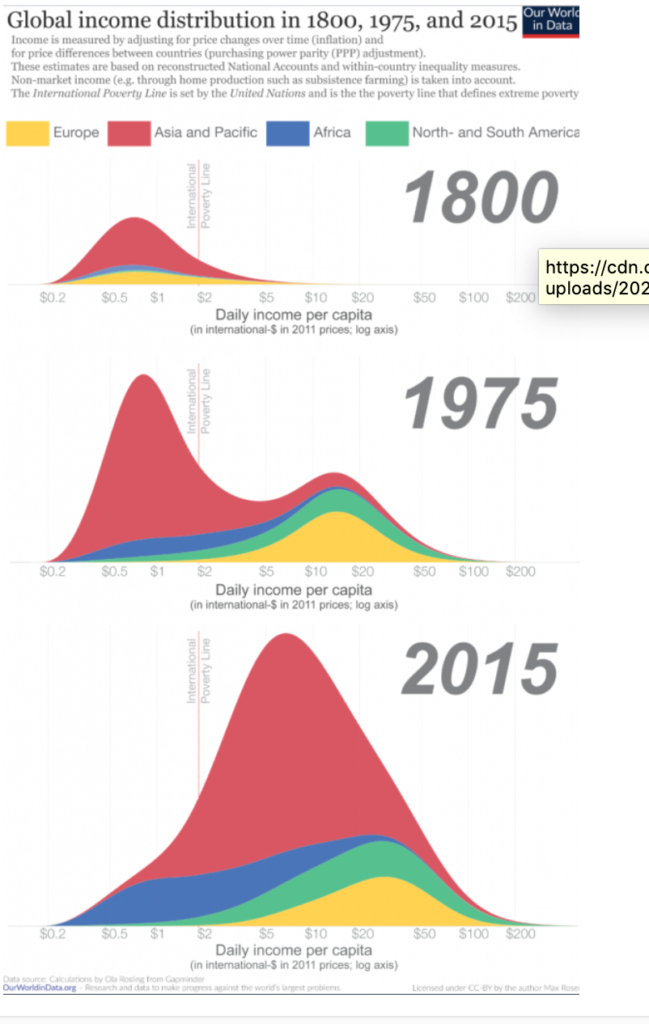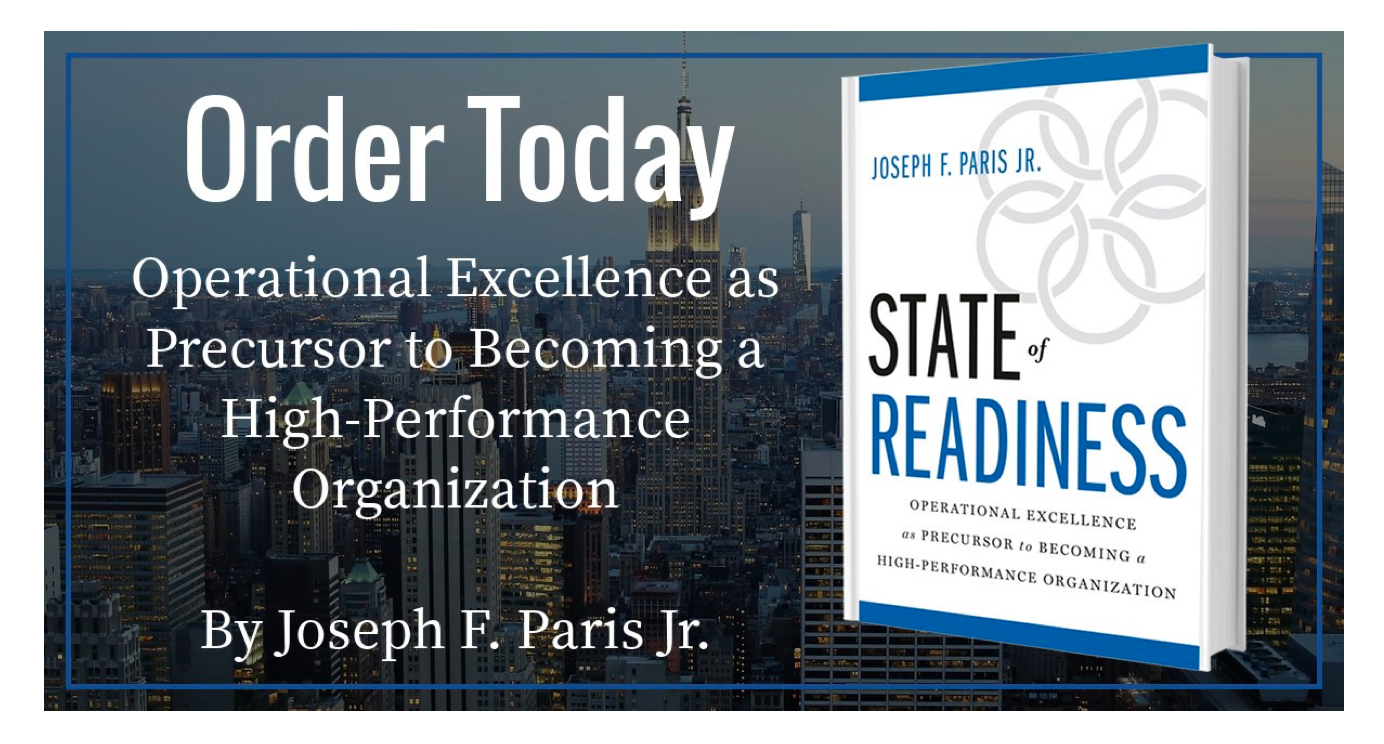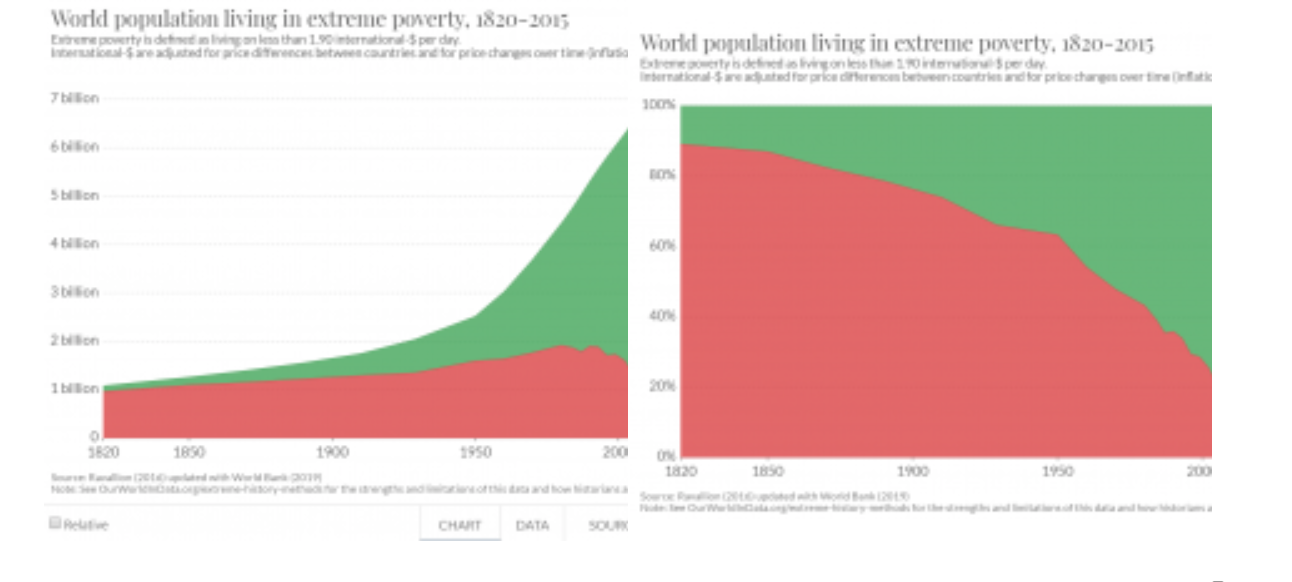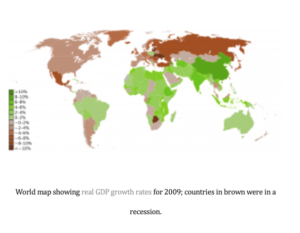 It is undoubtedly and incontrovertibly true that global extreme poverty has declined as capitalism has driven globalization – the trade between and among nations – to increase over time. Certainly, there are arguments to be made that the growth in wealth has also been increasingly concentrated in the hands of fewer people, but the world as a whole has benefited. The charts below from Our World in Data, showing the number of people living in extreme poverty from 1820 to present, clearly demonstrate that the economic benefit of globalization has been as positive as it has been apparent
It is undoubtedly and incontrovertibly true that global extreme poverty has declined as capitalism has driven globalization – the trade between and among nations – to increase over time. Certainly, there are arguments to be made that the growth in wealth has also been increasingly concentrated in the hands of fewer people, but the world as a whole has benefited. The charts below from Our World in Data, showing the number of people living in extreme poverty from 1820 to present, clearly demonstrate that the economic benefit of globalization has been as positive as it has been apparent
And the benefits of globalization have been realized worldwide, not just localized to western countries.
For instance, in 1800 the vast majority of people around the world lived in poverty.
By 1975, those people living in Europe and the Americas had seen their income levels grow well past the poverty levels with Asia, the Pacific, and Africa being laggards.
And by 2015, the vast majority of people around the world had grown out of poverty with some of Asia and the Pacific having a minority in poverty – but with Africa still being a laggard.
This decrease in poverty and increase in income could only have been achieved through globalization – which accelerated as the efficiency and speed of transportation and logistics improved.However, with globalization, as with any “new way”, comes risks. Some are easy to see, such as relying too much on a customer or vendor and having supply chains stretched beyond their capacity or capability to deliver. Some are less obvious.
However, with globalization, as with any “new way”, comes risks. Some are easy to see, such as relying too much on a customer or vendor and having supply chains stretched beyond their capacity or capability to deliver. Some are less obvious.
And there is always political risk and the challenges of uncertainty that come along with changes in alliances and views of the world. But the pursuit of improving one’s circumstances has always been a primary driver and motivator of mankind throughout the ages.
 In this pursuit, it is often and easy to overlook, ignore, or give inadequate attention to the risks and peril that may exist. And, more often than not, it’s not so much that we chose to not consider the risks, we are simply unaware that they exist – or if we are aware, we don’t understand the true nature of the risks.
In this pursuit, it is often and easy to overlook, ignore, or give inadequate attention to the risks and peril that may exist. And, more often than not, it’s not so much that we chose to not consider the risks, we are simply unaware that they exist – or if we are aware, we don’t understand the true nature of the risks.
The Black Death
The year is 1347. The place is the port city of Messina in Sicily. Twelve ships arrived from the Black Sea and to the horror of all who greeted it, all of the crew were either dead or dying – covered in black boils that oozed blood and pus. Even though the authorities quickly ordered the ships and crew back out to sea, it was too late. The Black Death (or Black Plague, or simply The Plague) had arrived to Europe.
By the time it was over, more than 20 million people – a full third of the population then in Europe – would die of the disease.
But people had heard of this disease well before it reached the shores of Europe. It had struck China, India, the Middle East; following the trade routes established by earlier explorers who established the Silk Road; such as Marco Polo circa 1271 and 1295.
Indeed, “globalization” had started, and with it new risks unimagined before. Today we know the Black Death was caused by a bacillus – a bacteria – that could be spread by traveling through the air as well as through the bite of infected rats and fleas.
Although a few people per year still die from the Black Death, it is not as much a threat today because we can fight-off a bacterial infection with the use of antibiotics.
Early Pandemics to and from the Americas
Fast forward a little over one hundred years, Christopher Columbus landed at an island he would name San Salvador in 1492. Although unresolved, it is believed to have been one of the islands in the Bahamas. The people of mainland Europe had discovered what would soon be referred to as the New World; the continents of what will eventually be called the Americas.
The tragedy is that the Europeans brought with them to the New World diseases such as Small Pox, Measles, Influenza and other viruses. These viruses decimated the populations of the Indigenous Peoples of the Americas who, having never been exposed, had no immunity to the new diseases. It is also believed that the bacterial infection, Syphilis, originated in the New World and was brought back to Europe by European explorers to the New World.
World War-1 and the Spanish Flu
World War 1 (WW1) began in 1914 with the assassination of Archduke Franz Ferdinand of Austria and presumptive heir to the Austria-Hungary throne in Sarajevo. This event, in effect, served as a tripwire and the systemic call to war as alliances, treaties, and promises made led much of Europe to war – with the eventual, if reluctant, entry of the United States in 1917.
Although referred to as a “World War”, the fighting took place almost exclusively in Europe and the Ottoman Empire with other contributing fighting forces but not engaged in fighting in their own countries (with the noted exception of the Union of South Africa and it’s campaigns in German Southwest Africa; now Namibia).
The real threat globally was the Spanish Flu. The Spanish Flu did not originate in Spain, but Spain was not involved in the fighting in WW1 and, not being subject to news blackouts, widely reported on the pandemic. Thus giving the illusion to others that Spain was the origin.
The first cases were actually reported at the US Army base in Fort Riley, Kansas on March 4th, 1918. And the movement of a massive amount of people and apparatus around the world because of WW1 accelerated its being spread and amplified the effects. By the time the Spanish Flu had run its course, an estimated 20-50 million people from around the world will have died from it (including an estimated 675,000 in the United States).
I combine these two events into one global event because the Spanish Flu would not have likely become a pandemic without WW1 acting as the delivery vehicle for its being spread globally.
The Great Depression
The start of the Great Depression was marked by the stock market crash in October 1929 which sent panic through the exchanges on Wall Street and erased the wealth of millions of investors and millions more as they lost their jobs. The Dust Bowl of the 1930’s crushed much of the farming in the Southern Plains causing a mass exodus of the people there to seek new lives elsewhere.
Actions taken by governments in the early 1930’s guaranteed that amplification and spread of the difficulties.
The first action was the Tariff Act of 1930 (usually referred to as the Smoot-Hawley Tariff Act of 1930) which levied tariffs on a wide range of goods imported into the United States – and which resulted in retaliatory tariffs being enacted by the nations effected by the US tariffs. This caused a 67% reduction in economic activity between the US and its trading partners and smothered economic activity by; elongating the duration of the Great Depression, amplifying the economic damage within the US, and spreading the negative effects further and deeper internationally.
The second was the disorderly dismantling of the gold-standard (a monetary system where currencies are backed by gold) upon which the monetary systems of developed nations were based and mutually agreed. Seeing Britain abandon the gold standard in 1931 and its Keynesian effects on its economy, the US followed suit in 1933 by partially abandoning the gold standard (although the complete abandonment of the gold standard would not occur by the US until President Richard Nixon shocked the world by announcing that the States would no longer convert dollars to gold at a fixed rate).
World War 2
The first (and only) truly global war was World War 2 which was fought in all hemispheres and directly involved over 30 countries. It saw countries become allied, some reluctantly (the United States did not want to become involved with another European war) and some who were aligned merely because they had a common foe; for instance Japan and Italy with Germany, and Russia with the United States and Great Britain.
For Europe, the seeds for the rise of a resentful and belligerent Germany were sown in the Treaty of Versailles that ended WW-I, and in particular Article 231 which held Germany fully and solely responsible for the war and required that Germany pay nearly unlimited reparations.
In the Pacific, Japan’s rise originated with its rivalry and conflict with China with Japan’s invasion of Manchuria in 1931 both escalating and accelerating the conflict – and causing it to expand to include Korea and then beyond.
But Japan has no natural resources such as oil, iron, and rubber and the continued conflict was pushing Japan over the edge economically and militarily. That the international community viewed Japan as an aggressive rogue state meant that it’s options for getting support for its efforts was very limited. This left it only one option; to take what it needed from Russia in Siberia and the South Pacific.
HIV/AIDS
The first pandemic since the Spanish Flu, the HIV/AIDS became a pandemic in the 1980’s and came upon the world with great stealth. The symptoms for being infected with the HIV retrovirus itself took the form of influenza or mononucleosis with many victims displaying no symptoms at all. But as HIV attacked the immune system, other common maladies which prey on those with weakened immune systems began to develop. These maladies caused by HIV were indicative of being infected by HIV becoming AIDS.
Initially infecting mostly those in the male homosexual community and drug users who took their drugs by injection, it was first believed to be related to those who belonged to those communities of people. But as more people outside of that community, namely hemophiliacs and those who had blood transfusions, awareness began to build that the disease was not limited to these communities.
Because of the long period of time between becoming infected and developing AIDS, it took the medical community a long time to discover the HIV virus and that it developed into AIDS; and longer still to develop a treatment (presently, there is no cure). This same lag-time, along with more people traveling the world, created an environment where HIV could spread around the world.
9/11
On that fateful day of September 11th, 2001, four passenger jets were hijacked by terrorists from Al-Quida, a terrorist organization founded and led by Osama Bin Laden. Two flew into the World Trade Center and caused its collapse. One flew into the Pentagon. And one crashed in a field in Pennsylvania as a group of incredibly brave passengers attempted to retake the plane from the hijackers.
As with the conclusion of WW-1 being a cause of WW-2, it could be reasoned that the conclusion of WW-1 (with the ham-fisted way the Ottoman Empire was divided up, failing to take into account tribal and religious demarcations), and WW-2 (with the Cold War and the creation of Israel with the regional strife that resulted) are the causes that (eventually) led to 9/11.
The manner in which these decisions were made and implemented by those outside of the region on those inside sowed the seeds for regional instability – even within nations that were created. Instabilities that exist to this date.
And the Cold War pitted the West against the Soviet Union who, in their struggles to win influence in the region, operated with their interests in mind rather than the countries in the region and those who lived there.
The defeat and withdrawal of the Soviet Union in the Soviet-Afghan War by the Mujahedeen who were indirectly supplied weapons by the United States left a leadership vacuum and subsequent chaos within the country – and became ripe for it to become the base of operations for Al-Qaeda; and allowed for the possibility of 9/11 to happen.
The Great Recession
According to Gordon Gekko, the fictional and unabashed capitalist played by Michael Douglas in the movie “Wall Street” directed by Oliver Stone; “Greed is good.”
Indeed and as mentioned earlier, people have a innate motivation to better their circumstances – and this often leaves them blind to the perils that exist.
The Great Recession started in 2007 and became a full-fledged crisis in 2008. But its primary root-cause was earlier starting in 2002 as a housing bubble started to form in the United States and which peaked in 2006. It was during this period that the selling price (and perceived value) of homes was climbing at a rate multiple times the historic rate and banks were only too happy to lend money to anyone who wanted a loan to purchase a house. Banks even started to approve “NINJA” (No Income, No Job or Assets) loans with the expectation that the equity would continue to build at an unprecedented rate “forever”. Known as subprime loans, these loans along with other loans were bundled together and sold as supposedly low-risk mortgage-backed securities to investors.
Unfortunately, “forever” is never as long as people believe it will be.
When the growth stopped, the people who took out the subprime loans started to default on en-masse creating a sudden and substantive burden on the banks. With foreclosures mounting, the assets that backed the securities decreased in value very quickly and very steeply. And the investors who purchased the securities soon found themselves with securities that were worthless or nearly worthless.
What made the crisis global was that these securities were purchased by investors all over the world. Some were private investors, some were institutional investors, but most were other banks. And the resulting pain was shared by all.
We are now in the midst of the viral COVID-19 Pandemic.
Note: At this point and since the situation is very fluid with much of what we do “know” is seemingly subject to contradiction every day – we simply don’t know what we don’t know. So, I will only share the link to Wikipedia since it is an aggregate single source of information (although the information provided subject to the manipulation of those who have an interest in manipulation – caveat emptor).
By all accounts, its origin (at least where it first became known) was in the city of Wuhan in China. That COVID-19 was “new”, it took some time to understand that it was new. This delay, combined with; the virus being contagious while the victim was asymptomatic (a period that is presently understood to be up to two weeks); the Chinese New Year celebration started on January 25th, 2020 with many Chinese going abroad to vacation; and that modern travel is such that people can be anywhere in the world within a day; offered the opportunity for the virus spread far and wide very rapidly and largely undetected until it was too late.
Undoubtedly this event and the data being collected will be studied long after the crisis has abated. So I won’t begin to offer any hypothesis or suggestions here. It’s too early and I/we just don’t know enough for it to be appropriate at this time. But what can be safely stated is that globalization made, what might have been a localized challenge in some other time when people were not able to travel the world so quickly and so easily, into a challenge the entire world must face.
Conclusion
The people of the entire world have undoubtedly benefited from globalization driven by capitalism. Far fewer are living in poverty and this trend continues. With less poverty, people are able to enjoy lives that are longer and with living conditions being not as harsh.
But for your consideration;
- from 1300 to 1900, a span of 600 years, there were two (2) events that challenged the known world; the Black Death which was spread by traders along the silk road, and the spread of viruses to and from the America’s after their discovery by those in mainland Europe.
- In the 1900’s, there were four (4) such events; WW1 and the Spanish Flu, the Great Depression, WW2, and HIV/AIDS.
- In the last twenty (20) yearsthere have been three (3); the terrorist attacks of 9/11 and what led up to them and what has happened since, the Great Recession, and now COVID-19.
Each and every global pandemic or conflagration has as its root-cause a consequence of globalization. And the pace of these global challenges has quickened as globalization has increased.
Capitalism driven globalization is here to stay and will only become more widespread and reach deeper into our civilization.
But we need to start doing a better job of using our imaginations with regards to the risks, be more attentive to the tell-tails and recognized when a risk becomes greater, draw from past lessons learned, and make decisions faster, and devise and deploy decisive responses more rapidly. And we need do a better job of studying Chaos Theory, and specifically the Butterfly Effect, to seek, analyze, model, and simulate the risks associated with globalization and an increasingly integrated world.
We need to remember that time is the enemy and we all need to be in a better “state of readiness” for the next time a potential risk becomes a real threat.
Note: This article is intended to be about the risks of globalization and not about any of the individual incidents cited as examples of that risk – except as examples. Accordingly, each of these events is very complex and this article omits a great many details and nuances except for their being caused and influenced by globalization.
Paris is an international expert in the field of Operational Excellence, organizational design, strategy design and deployment, and helping companies become high-performance organizations. His vehicles for change include being the Founder of; the XONITEK Group of Companies; the Operational Excellence Society; and the Readiness Institute.
He is a sought-after speaker and lecturer and his book, “State of Readiness” has been endorsed by senior leaders at some of the most respected companies in the world.
Click here to learn more about Joseph Paris or connect with him on LinkedIn.
Bio:
 Paris is an international expert in the field of Operational Excellence, organizational design, strategy design and deployment, and helping companies become high-performance organizations. His vehicles for change include being the Founder of; the XONITEK Group of Companies; the Operational Excellence Society; and the Readiness Institute.
Paris is an international expert in the field of Operational Excellence, organizational design, strategy design and deployment, and helping companies become high-performance organizations. His vehicles for change include being the Founder of; the XONITEK Group of Companies; the Operational Excellence Society; and the Readiness Institute.
He is a sought-after speaker and lecturer and his book, “State of Readiness” has been endorsed by senior leaders at some of the most respected companies in the world.
Click here to learn more about Joseph Paris or connect with him on LinkedIn.

